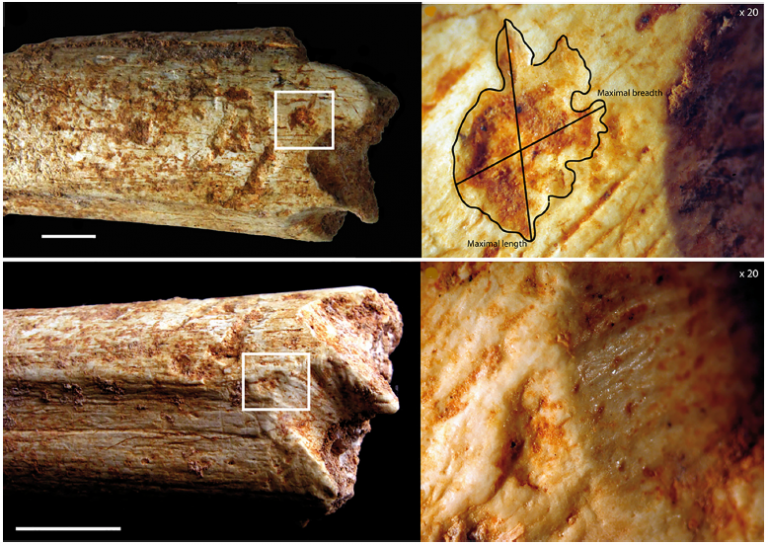500,000 year old human leg bone found with predator tooth marks
28 April 2016
In many Middle Pleistocene sites, the co-occurrence of hominins with carnivores, who both contributed to faunal accumulations, suggests competition for resources as well as for living spaces.
 Despite this, there is very little evidence of direct interaction between them to-date. Recently, a human femoral diaphysis has been recognized in South-West of Casablanca (Morocco), in the locality called Thomas Quarry I. This site is famous for its Middle Pleistocene fossil hominins considered representatives of Homo rhodesiensis. The bone was discovered in Unit 4 of the Grotte à Hominidés (GH), dated to c. 500 ky and was associated with Acheulean artefacts and a rich mammalian fauna. Anatomically, it fits well within the group of known early Middle Pleistocene Homo, but its chief point of interest is that the diaphyseal ends display numerous tooth marks showing that it had been consumed shortly after death by a large carnivore, probably a hyena. This bone represents the first evidence of consumption of human remains by carnivores in the cave. Whether predated or scavenged, this chewed femur indicates that humans were a resource for carnivores, underlining their close relationships during the Middle Pleistocene in Atlantic Morocco.
Despite this, there is very little evidence of direct interaction between them to-date. Recently, a human femoral diaphysis has been recognized in South-West of Casablanca (Morocco), in the locality called Thomas Quarry I. This site is famous for its Middle Pleistocene fossil hominins considered representatives of Homo rhodesiensis. The bone was discovered in Unit 4 of the Grotte à Hominidés (GH), dated to c. 500 ky and was associated with Acheulean artefacts and a rich mammalian fauna. Anatomically, it fits well within the group of known early Middle Pleistocene Homo, but its chief point of interest is that the diaphyseal ends display numerous tooth marks showing that it had been consumed shortly after death by a large carnivore, probably a hyena. This bone represents the first evidence of consumption of human remains by carnivores in the cave. Whether predated or scavenged, this chewed femur indicates that humans were a resource for carnivores, underlining their close relationships during the Middle Pleistocene in Atlantic Morocco.
Pleistocene Hominins as a Resource for Carnivores: A c. 500,000-Year-Old Human Femur Bearing Tooth-Marks in North Africa (Thomas Quarry I, Morocco)
Camille Daujeard, Denis Geraads, Rosalia Gallotti, David Lefèvre, Abderrahim Mohib, Jean-Paul Raynal, Jean-Jacques Hublin
 Close
Close

